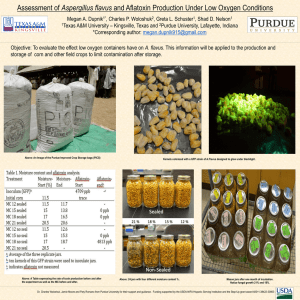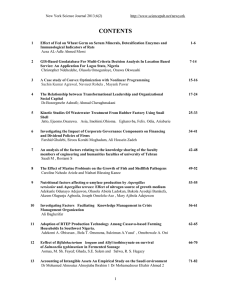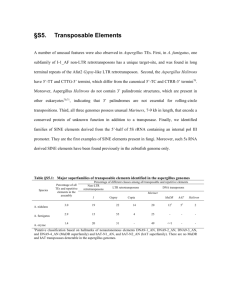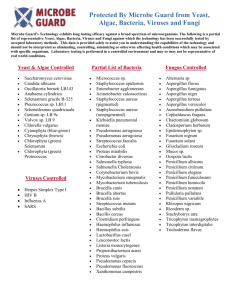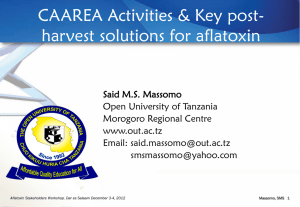Saranraj85
advertisement
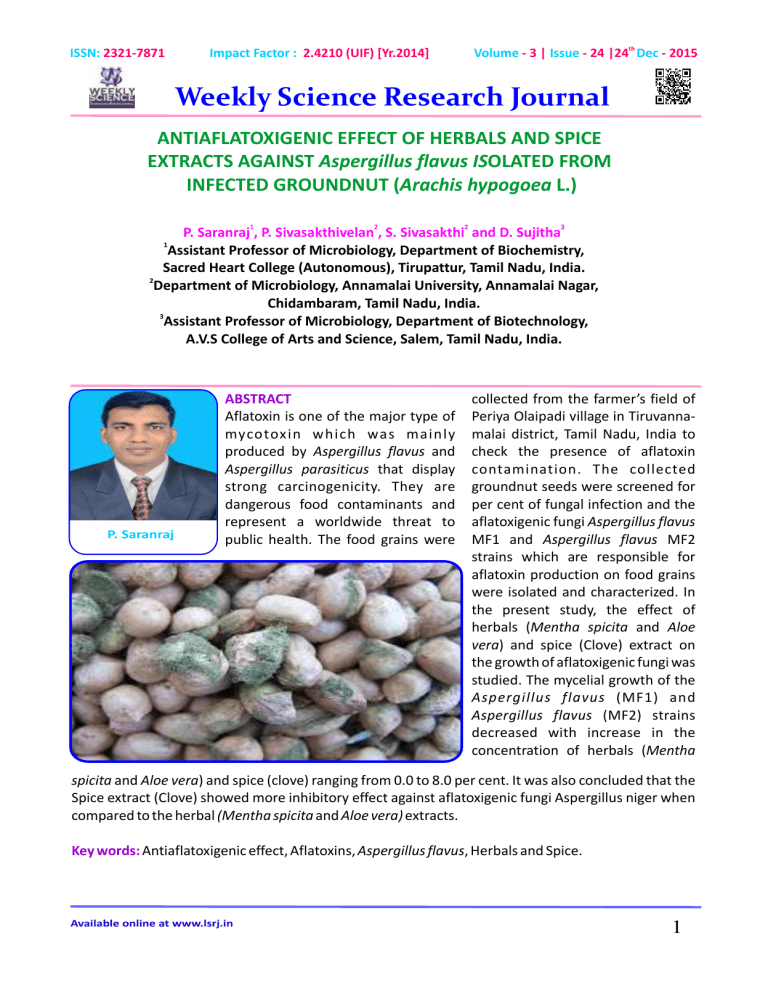
ISSN: 2321-7871 Impact Factor : 2.4210 (UIF) [Yr.2014] Volume - 3 | Issue - 24 |24th Dec - 2015 Weekly Science Research Journal ANTIAFLATOXIGENIC EFFECT OF HERBALS AND SPICE EXTRACTS AGAINST Aspergillus flavus ISOLATED FROM INFECTED GROUNDNUT (Arachis hypogoea L.) P. Saranraj1, P. Sivasakthivelan2, S. Sivasakthi2 and D. Sujitha3 1 Assistant Professor of Microbiology, Department of Biochemistry, Sacred Heart College (Autonomous), Tirupattur, Tamil Nadu, India. 2 Department of Microbiology, Annamalai University, Annamalai Nagar, Chidambaram, Tamil Nadu, India. 3 Assistant Professor of Microbiology, Department of Biotechnology, A.V.S College of Arts and Science, Salem, Tamil Nadu, India. P. Saranraj ABSTRACT Aflatoxin is one of the major type of mycotoxin which was mainly produced by Aspergillus flavus and Aspergillus parasiticus that display strong carcinogenicity. They are dangerous food contaminants and represent a worldwide threat to public health. The food grains were collected from the farmer’s field of Periya Olaipadi village in Tiruvannamalai district, Tamil Nadu, India to check the presence of aflatoxin contamination. The collected groundnut seeds were screened for per cent of fungal infection and the aflatoxigenic fungi Aspergillus flavus MF1 and Aspergillus flavus MF2 strains which are responsible for aflatoxin production on food grains were isolated and characterized. In the present study, the effect of herbals (Mentha spicita and Aloe vera) and spice (Clove) extract on the growth of aflatoxigenic fungi was studied. The mycelial growth of the Aspergillus flavus (MF1) and Aspergillus flavus (MF2) strains decreased with increase in the concentration of herbals (Mentha spicita and Aloe vera) and spice (clove) ranging from 0.0 to 8.0 per cent. It was also concluded that the Spice extract (Clove) showed more inhibitory effect against aflatoxigenic fungi Aspergillus niger when compared to the herbal (Mentha spicita and Aloe vera) extracts. Key words: Antiaflatoxigenic effect, Aflatoxins, Aspergillus flavus, Herbals and Spice. Available online at www.lsrj.in 1 ANTIAFLATOXIGENIC EFFECT OF HERBALS AND SPICE EXTRACTS AGAINST Aspergillus flavus ISOLATED ............ 1. INTRODUCTION: Harvested grains are colonized by various species of Aspergillus due to the presence of its nutritive content and moisture. Under such conditions, crops lead to deterioration and mycotoxin production. Among all the mycotoxins, particularly aflatoxin B1 is the most toxic form for mammals and possesses hepatotoxic, teratogenic and mutagenic properties which results in causing damages such as toxic Hepatitis, hemorrhage, edema, immunosuppression and hepatic carcinoma. Poor harvesting practices, improper storage and less than optimal conditions during transportation, marketing and processing can also contribute to fungal growth (Ali and Sayad, 2000; Larous et al., 2007). Aflatoxin production is particularly favoured by very moist conditions. Aflatoxins occur in an extremely heterogeneous fashion in food commodities. Current control measures are aimed at controlling fungal growth (Mohamad Hadzri Yaob et al., 2008). Treatment of food substance was usually carried out with chemicals such as ammonia, acids and bases or with food preservatives and by biological methods. These methods require sophisticated equipment and expensive chemicals or reagents (Carlos Manuel Bucico, 2005; Passone, 2007; Saranraj et al., 2012). Natural products may regulate the cellular effects of aflatoxins and evidence suggests that aromatic organic compounds of spices can control the production of aflatoxins. The use of spices in preserving food products has been traditional and they are cultivated in many countries such as India, Japan and Russia (Sung – Jo Kang et al., 2001; Williams et al., 2004; Saranraj et al., 2010). Spices occupy a prominent place in the traditional culinary practices and are indispensable part of daily diets of millions of people all over the world. They are essentially flavouring agents used in small amounts and are reported to have both beneficial effect and antimicrobial properties, if properly stored. Their antimicrobial properties have been found to be mostly due to the presence of alkaloids, phenols, glycosides, steroids, essential oils, coumarins and tannins (Hatti et al., 2009; Siva Sakthi et al., 2011). Natural plant extracts are of interest as a source of safer or more effective substitutes for synthetically produced antimicrobial agents and may provide an alternative way to prevent food or feed from fungal contamination. Powders and extracts of various herbs, spices and essential oils have been reported to have antimicrobial activity and some also to inhibit aflatoxin formation (Herman et al., 2007). The present study was undertaken to examine the inhibitory effect of herbals extract and spice extract on the growth inhibition of aflatoxigenic fungi Aspergillus flavus. 2. MATERIALS AND METHODS 2.1. Collection of aflatoxin contaminated Groundnut The aflatoxin contaminated Groundnut (Arachis hypogoea L.) was collected from the farmer’s field of Periya Olaipadi village in Tiruvannamalai district, Tamil Nadu, India for the present research. 2.2. Screening of Groundnut for per cent of fungal infection 2.2.1. Percent of fungal infection in Groundnut As the storage fungi can withstand very high osmotic pressure, a high osmotic Sucrose medium was used as a selective medium for screening the oil seed Groundnut for percent of fungal infection. The groundnut was unsterilized and surface sterilized with 0.1 % mercuric chloride solution for 50 seconds and washed with 7.5 % sodium chloride were placed in the Sucrose medium by direct plating technique using sterile forceps, a market paper template i.e., blue print was kept under the plates for even distribution of seeds. The number of groundnut was 10 seeds respectively. The number of groundnut paced in the plates depended on the size of the seeds. The plates were incubated at room Available online at www.lsrj.in 2 ANTIAFLATOXIGENIC EFFECT OF HERBALS AND SPICE EXTRACTS AGAINST Aspergillus flavus ISOLATED ............ temperature at 30 ºC and observed for the growth of colony for 3rd day to 5th day. The infection per cent of unsterilized and surface sterilized seeds were determined by using the below given formula. 2.3. Isolation and characterization of aflatoxigenic fungi 2.3.1. Isolation The fungal cultures found in infected seeds were observed under low power and high power magnification of the compound microscope. Among the various species isolated, Aspergillus flavus was identified as predominant in the infected seeds and used for further studies. The per cent fungal infection was high in groundnut seeds and the aflatoxigenic fungal cultures were predominant on aflatoxigenic fungal culture were isolated using Sucrose medium from groundnut seeds and named as Aspergillus flavus MF1 and Aspergillus flavus MF2. 2.3.2. Morphological and microscopic examination of the aflatoxigenic fungal isolates The fungal isolates plated on Sucrose medium to study morphological characters viz., colony colour, texture, colour on the reverse side of plates, colony diameter and morphological characters viz., morphological characters, conidia, conidial heads and phialides. 2.4. Studies on the inhibition of Aspergillus flavus mycelial growth 2.4.1. Effect of herbal extracts on inhibition Aspergillus flavus of mycelial growth Two herbal extracts viz., Mentha spicita (Puthina) and Aloe vera were used to study the comparative inhibitory effect on the growth and aflatoxin production of Aspergillus flavus (MF1 and MF2). The Sabouraud’s dextrose broth was prepared and 50 ml of broth was transferred to 100 ml Erlenmeyer flasks in different concentration. The herbal extracts at various concentrations viz., 0.0 %, 1.0 %, 2.0 %, 3.0 %, 4.0 %, 6.0 % and 8.0 % were prepared and added to the broth was inoculated with a 4 mm Aspergillus flavus disc (MF1and MF2) separately. After the incubation period, the culture broth was filtered and dry weight of the Aspergillus flavus mycelial mat was recorded. 2.4.2. Effect of spice extract on inhibition of mycelial growth. The clove spice extracts was used to study the inhibitory effect on the mycelial growth of Aspergillus flavus (MF1 and MF2). The spice extract was prepared by taking (5 g) spice powder on 50 ml of solvents like methanol. The extracts were kept in shaker for 24 hrs. Then, extracts were filtered with the help of muslin cloth. The Sabouraud’s dextrose broth was prepared and 50 ml of broth was transferred to 100 ml Erlenmeyer flasks in different concentration. The spice extracts viz., 0.0 %, 1.0 %, 2.0 %, 3.0 %, 4.0 %, 6.0 % and 8.0 % were prepare and added to the broth and inoculated with a 4 mm of Aspergillus flavus disc (MF1and MF2) stains. After the incubation period, the culture broth was filtered and dry weight of the mycelial mat was recorded. 3. RESULTS AND DISCUSSION 3.1. Screening of Groundnut seeds for percent of fungal infection The per cent of fungal infection in surface sterilized and unsterilized Groundnut seeds were enumerated and the findings were furnished in Table - 1. Among the 10 groundnut seeds, the aflatoxin Available online at www.lsrj.in 3 ANTIAFLATOXIGENIC EFFECT OF HERBALS AND SPICE EXTRACTS AGAINST Aspergillus flavus ISOLATED ............ infection per cent in the surface sterilized groundnut seeds was 40.0 % and unsterilized groundnut seeds was 70.0 %. The fungal cultures found in infected seeds were observed under low power or high power magnification of the compound microscope and identified. Among the various species, Aspergillus flavus, Aspergillus niger, Aspergillus parasiticus and Penicillium sp. were identified in the infected groundnut seeds and the majority of the contamination was caused by Aspergillus flavus so it was selected for the further research. Table – 1: Per cent of fungal infection in Groundnut Sample Seed Number of seeds plate-1 Groundnut 100 Unsterilized seeds Number Per cent of seeds of infected infection 70.0 70.0 Surface sterilized seeds Number Per cent of of seed infection infec tion 40.0 40.0 Mean percent of infection 55.0 3.2. Isolation and characterization of aflatoxigenic fungal strains The Aspergillus flavus found in infected groundnut seeds were observed under microscope. The fungi Aspergillus flavus was predominant in the infected seeds and isolated for further studies. The Aflatoxigenic Aspergillus flavus MF1 and Aspergillus flavus MF2 strains were isolated from groundnut seeds using the selective medium and examined for colony morphology and conidial characters and are presented. Based on the morphological characters viz., colony colour (yellow green becoming brownish with age), texture (velvety), colour on reverse side of the plates (cramish yellow), colony diameter (4.0 to 4.8 cm) and through microscopic examination of conidial characters such as conidiophores (coarsely roughened), conidial (globose and single nucleate without side roughened walls), conidial heads (split into loosely organising), phialides (uniseriate in arrangement) the fungal isolate MF1 and MF2 strains were identified as Aspergillus flavus. 3.3. Effect of herbal extracts on Aspergillus flavus mycelial growth The effect of herbal extracts on the inhibition of mycelial growth of the Aspergillus flavus strains MF1 and MF2 were studied and the results were presented in Fig – 1 and Fig - 2. The mycelial growth of the Aspergillus flavus (MF1 and MF2) strains detected with increase in concentration of herbal extract (0 % to 8.0 %) when compared to control. Among the herbal extract levels tested, Mentha spicita (Puthina) (0 %) recorded higher mycelial growth (MF1 - 290 mg and MF2 - 282 mg) and lower mycelial growth (Mf1 - 185 mg and MF2 - 160 mg) was recorded at 8.0 %. Aloe vera (0 %) recorded higher mycelial growth (MF1 - 290 mg and MF2 - 272 mg) and lower mycelial growth (MF1 - 140 mg and MF2 125 mg) was recorded at 8.0 %. The result of this present research was in accordance with Siva Sakthi et al. (2011); Murugan and Saranraj (2011); Saranraj and Sivasakthivelan (2012); Ganesh et al. (2014); Kolanjinathan and Saranraj (2015). Available online at www.lsrj.in 4 ANTIAFLATOXIGENIC EFFECT OF HERBALS AND SPICE EXTRACTS AGAINST Aspergillus flavus ISOLATED ............ Fig – 1: Effect of Mentha spicita (Puthina) on inhibition of Aspergillus flavus mycelial growth Fig – 2: Effect of Aloe vera on inhibition of Aspergillus flavus mycelial growth 3.4. Effect of Spice extracts on mycelial growth The effect of Spice extract (Clove) on the inhibition of mycelial growth of the Aspergillus flavus strain MF1 and MF2 was studied and the results are presented in Fig – 3. The mycelial growth of the Aspergillus flavus (MF1 and MF2) strains detected with increase in concentration of spice extract (0 % to 8.0 %), compared to control. Clove showed higher mycelial growth of Aspergillus flavus at 0 % concentration of clove (MF1 - 185 mg and MF2 – No growth) and lower mycelial growth (MF1 – 185 and MF2 - No growth) was observed at 8 % concentration of clove. Similar results were reported by Houssou et al. (1980) on the effect of spice on the mycelial growth of toxigenic fungi. Eugenol extracted from cloves caused complete inhibition of the mycelial growth of Aspergillus flavus. The results of the present study were similar with the findings of Ogiehor and Ikenebomeh (2004); Odoemelam and Osu Available online at www.lsrj.in 5 ANTIAFLATOXIGENIC EFFECT OF HERBALS AND SPICE EXTRACTS AGAINST Aspergillus flavus ISOLATED ............ (2009); Reddy et al. (2009); Sekar et al., (2012); Bharathi et al. (2014); Saranraj and Sivasakthi (2014); Saranraj and Sujitha (2015). Fig – 3: Effect of Spice (Clove) on inhibition of Aspergillus flavus mycelial growth 4. CONCLUSION From this present research, we concluded that the mycelial growth of the Aspergillus flavus (MF1) and Aspergillus flavus (MF2) strains decreased with increase in the concentration of herbal (Mentha spicita and Aloe vera) and spice (clove) extracts ranging from 0.0 to 8.0 per cent. It was also concluded that the Spice extract (Clove) showed more inhibitory effect against aflatoxigenic fungi Aspergillus niger when compared to the herbal (Mentha spicita and Aloe vera) extracts. 5. REFERENCES 1) Ali, M. E and J. L. Sayed. 2000. Inhibition of aflatoxin B1 and ochratoxin A by some antimicrobial food additives. African Journal of Mycology and Biotechnology, 8: 23 -33. 2) Bharathi, T., K. Kolanjinathan and P. Saranraj. 2014. Antimicrobial activity of solvent extracts of Ocimum sanctum, Azadirachta indica and Phyllanthus amarus against clinical pathogens. Global Journal of Pharmacology, 8(3): 294 – 305. 3) Carlos Manuel Bucico, Hugo Albento Luna Olvera and Gloria Lavann. 2005. Effect of plant growth regulators on mycotoxigenic fungi. Mexican Journal of Phytopathology, 3 (8): 68 - 73. 4) Ganesh, P., R. Sureshkumar and P. Saranraj. 2014. Phytochemical analysis and antibacterial activity of Pepper (Piper nigrum L.) against some human pathogens. Central European Journal of Experimental Biology, 3(2): 36 – 41. 5) Hatti, A. D., P. P. Pangrikar, A. M. Chavan, D. P. Gadgile, R. B. Kakde and R. S. Gaikwad. 2009. Qualitative analysis of aflatoxin from Aspergillus flavus isolates. Recent Research in Science and Technology, 1 (1): 43 – 45. 6) Herman, C. J. J., R. Fuchs, S. Hagelberg and H. L. Storm, 2007. Thermogenic mycotoxins from Aspergillus fumigatus as a possible occupational health problem in Saw mills. Applied Environmental Microbiology, 53: 787 - 790. 7) Houssou, E.V., A. Joanna, Norman and D. Pimbley. 2009. Growth and aflatoxin production of Available online at www.lsrj.in 6 ANTIAFLATOXIGENIC EFFECT OF HERBALS AND SPICE EXTRACTS AGAINST Aspergillus flavus ISOLATED ............ Aspergillus flavus in wheat and barley. Trans Brazil Mycology Society, 84: 259 - 266. 8) Kolanjinathan, K and P. Saranraj. 2015. Pharmacological activity of Mangrove medicinal plants against pathogenic bacteria and fungi. Academic Discourse: An International Journal, 8(1): 1 – 15. 9) Larous, L., N. Hendel, J. K. Abood and M. Ghoul. 2007. The growth and production of patulin mycotoxin by Penicillium expansum on Apple fruits and its control by the use of propionic acid and sodium benzoate. Arabian Journal of Plant Protection, 25: 123 - 128. 10) Mohamad Hadzri Yaacob, Abdull Rahim, Mohamad Yusoff and Rahmalan Ahamad. 2008. Square wave cathodic stripping voltammetric technique for determination of aflatoxin B1 in Ground nut sample. The Malaysian Journal of Analytical Sciences, 12 (1): 132 - 140. 11) Murugan, T and P. Saranraj. 2011. Antibacterial activity of various solvent extracts of the Indian herbal plant Acalypha indica against human pathogens causing nosocomial infection. International Journal of Pharmaceutical and Biological Archives, 2(5): 1498 – 1503. 12) Odoemelam, S. A and C. I. Osu. 2009. Aflatoxin B1 contamination of some edible grains marketed in Nigeria. E - Journal of Chemistry, 6(2): 308 - 314. 13) Ogiehor, I. S and M. J. Ikenebomeh. 2004. Antimicrobial effects of sodium benzoate on the growth, survival and aflatoxin production potential of some species of Aspergillus in garri during storage. Pakistan Journal of Nutrition, 3: 300 - 303. 14) Passone, F. M. 2007. Aflatoxins production by Aspergillus flavus, isolated from different food stuffs commonly used in Jeddah region, Saudi Arabia. Pakistan Journal of Biological Science, 5: 69 - 74. 15) Reddy, K. R. N., C. S. Reddy and K. Muralidharan. 2009. Potential of botanicals and biocontrol agents on growth and aflatoxin production by Aspergillus flavus infecting rice grains. Food Control, 20: 173 – 178. 16) Saranraj, P and D. Sujitha. 2015. Mangrove Medicinal Plants: A Review. American – Eurasian Journal of Toxicological Sciences, 7(3): 146 – 156. 17) Saranraj, P and P. Sivasakthivelan 2012. Screening of antibacterial activity of medicinal plant Phyllanthus amarus against Urinary tract infection (UTI) causing bacterial pathogens. Applied Journal of Hygiene, 1 (3): 19 – 24. 18) Saranraj, P., D. Stella and D. Reetha. 2012. Bioactivity of Mangifera indica ethanol extract against human pathogenic microorganisms. Novus International Journal of Pharmaceutical Technology, 1 (1): 11 - 18. 19) Saranraj, P., D. Stella, K. Sathiyaseelan and Sajani Samuel. 2010. Antibacterial potentiality of Ethanol and Ethyl acetate extract of Acalypha indica against human pathogenic bacteria. Journal of Ecobiotechnology, 2 (7): 23 – 27. 20) Saranraj, S and S. Sivasakthi. 2014. Medicinal plants and its antimicrobial properties: A Review. Global Journal of Pharmacology, 8(3): 316 – 337. 21) Sekar, D., K. Kolanjinathan, P. Saranraj and K. Gajendiran. 2012. Screening of Phyllanthus amarus, Acalypha indica and Datura metel for its antimicrobial activity against selected pathogens. International Journal of Pharmaceutical and Biological Archives, 3(5): 1231 - 1236. 22) Siva Sakthi, S., M. Geetha and P. Saranraj. 2011. Pharmacological screening of Datura metel and Acalypha indica for its Antifungal activity against fungal pathogens. International Journal of Pharmaceutical Science and Health Care, 1 (2): 15 – 30. 23) Siva Sakthi, S., P. Saranraj and M. Geetha. 2011. Antibacterial evaluation and phytochemical screening of Datura metel leaf extracts against bacterial pathogens. International Journal of Pharmaceutical and Biological Archives, 2 (4): 1130 – 1136. 24) Sung- Jo Kang, Jin- Soon Kang and Duk- Hwa Chung. 2001. The effect of mixed culture with Available online at www.lsrj.in 7 ANTIAFLATOXIGENIC EFFECT OF HERBALS AND SPICE EXTRACTS AGAINST Aspergillus flavus ISOLATED ............ Aspergillus flavus and Aspergillus niger on aflatoxin production. Journal of Food Safety, 16(3): 206 - 211. 25) Williams, J. H., T. D. Phillips, J. E. Jolly, J. K. Stiles and C. Agarwal. 2004. Human aflatoxicosis of developing countries; a review of toxicology, exposure, potential health consequences: 541-545. Available online at www.lsrj.in 8
